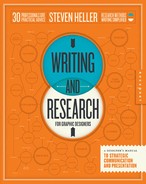
(Ray)
(Fogra 29_WF)Job:08-28858 Title:RP-Writing & Research for Graphic Designers
#175 Dtp:225 Page:20
018-055_28858.indd 20 8/30/12 4:41 PM
(Ray)
(Fogra 29_WF)Job:08-28858 Title:RP-Writing & Research for Graphic Designers
#175 Dtp:225 Page:21
018-055_28858.indd 21 8/30/12 4:41 PM
(Text)
WRITING
start start
FRONT BACK
(Ray)
(Fogra 29_WF)Job:08-28858 Title:RP-Writing & Research for Graphic Designers
#175 Dtp:225 Page:20
018-055_28858.indd 20 8/30/12 4:35 PM
(Text)
Some people, these days, read only Twitter or Facebook
feeds. From this statement you may anticipate a grumpy
lament like the current “reading is dead” canard. But
I am not entirely a grump, and this book is far from
a lament. Nonetheless, my assertion is quantifiable.
Long-form thoughtful reading is down; short-form
speed-reading is up. Still, the good news is that any
form of reading implies literacy. The bad news is that
speed-reading clogs the brain with minutiae and TMI
(too much information).
Reading and writing go hand in glove. Sure, it is possible to
read and never write an essay, article, or book in your life, but
it is impossible to write anything and never read. A philosopher
named Theodore Parker (1820–1860) would have agreed:
“The books that help you most are those which make you think
the most. The hardest way of learning is that of easy reading.”
Another venerated spokesman for reading, John Locke (1632–
1704), noted: “Reading furnishes the mind only with materials
of knowledge; it is thinking that makes what we read ours.”
Some of those old guys stole our best ideas, type master
Frederic Goudy wrote more than a hundred years ago, so we
should listen to what they say.
Certainly, media has transformed, mutated, and multiplied
since the seventeenth and eighteenth centuries when dinosaurs
such as Locke and Parker roamed the earth, but their notions
about reading are still valid. Reading is, as a copywriter wrote for
Meggs’ History of Graphic Design, was the first for-
mally written history textbook.
reading
The Key to Good Research and Writing
(Ray)
(Fogra 29_WF)Job:08-28858 Title:RP-Writing & Research for Graphic Designers
#175 Dtp:225 Page:21
018-055_28858.indd 21 8/30/12 4:35 PM

(Ray)
(Fogra 29_WF)Job:08-28858 Title:RP-Writing & Research for Graphic Designers
#175 Dtp:225 Page:22
018-055_28858.indd 22 8/30/12 4:41 PM
(Ray)
(Fogra 29_WF)Job:08-28858 Title:RP-Writing & Research for Graphic Designers
#175 Dtp:225 Page:23
018-055_28858.indd 23 8/30/12 4:41 PM
Writing & research for graphic designers
(Text)
22
1 2
3 4
(Ray)
(Fogra 29_WF)Job:08-28858 Title:RP-Writing & Research for Graphic Designers
09-C67944 #175 Dtp:225 Page:22
018-055_C67944.indd 22 9/22/12 11:25 AM
section 1
the three r’s : reading, writing, and research part one : reading
(Text)
23
an old public service TV commercial, “fundamental.” It is not
enough to read only captions in a visual book. The text is there
to be read too.
While it is perfectly allowable to skim or glean information
from a text, actually reading an article or a book from begin-
ning to end is ultimately a more pleasurable and cognitively
valuable experience. Yet whichever way one chooses to read—
front to back, back to front, middle to wherever—the goals are
the same: enjoyment and knowledge.
Yet this is a quid pro quo situation. If an author gives you
those pleasures, as a writer you should be able to return the
favor—or strive to do so—for others. Reading provides models.
Since different writers work in varied styles, it is likely that
reading a variety of authors will add to your skill set: Some of
their approaches will inform your own proclivities. I am not
advocating blatant copying. But if the shoe (or approach) fits . . .
well, borrow techniques that will allow for the most expressive
flexibility. Writing is about finding a voice. Personality is key,
but structure is essential. Reading others’ work can help build
the foundation for that structure.
Reading should not be a chore. But it can be a muscle-toning
exercise. Reading other writers’ work invariably triggers one’s
own writing. Emulating another writer is as valuable (and
flattering) as enjoying his text, and is sometimes unavoidable.
What to Read
In the fictitious twenty-fourth century, as a respite from
seeking out new worlds, Star Trek’s Jean-Luc Picard sits in
his captain’s seat with a rare, leather-bound relic in his hand.
Despite predictions to the contrary, the book in the future is
still viable (at least in science fiction). Yet as boundless as it
may be, the definition of a book may demand revision. Digital
“readers” are making inroads and the iPad is the future. Yet
even in the most futuristic science fiction projections, the book
continues to hold a place of honor.
You are reading this book (and have gotten this far) because
you want to write about design. So, in addition to reading your
favorite fiction and nonfiction, poetry and verse, how-to and
self-help, children’s and young adult, as well as newspapers
and magazines in whichever media you choose—in print or
5
What to read influences how to write.
Here are four of the leading design
magazines known for smart writing
and exciting design.
1 IDEA from Japan serves a regular diet
of international news and features.
2 Eye from the U.K. balances graphic,
motion and dimensional design with
a strong leaning toward history.
3 Communication Arts from the U.S. has
long advocated the interdisciplinary
side of graphic design.
4 Print, the oldest running graphic
design magazine, views popular
culture through the graphic lens.
5 Bibliographic, is a survey of 100 of the
most significant graphic design text
and picture books. Although not the
canon, it comes close to being the
optimum reading list.
(Ray)
(Fogra 29_WF)Job:08-28858 Title:RP-Writing & Research for Graphic Designers
09-C67944 #175 Dtp:225 Page:23
018-055_C67944.indd 23 9/22/12 11:25 AM
..................Content has been hidden....................
You can't read the all page of ebook, please click here login for view all page.
